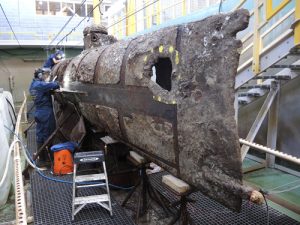Researcher to give update on the Hunley in free Relic Room lecture
October 14, 2019H. L. Hunley became the first submarine in history to sink an opposing warship in battle. The sub itself sank shortly thereafter in Charleston Harbor, and all eight hands were lost.
In 2000, she was raised from the seabed, and researchers began the painstaking process of stripping away the encrusted layer of sand, sediment and shells that had built up slowly over time, concealing the vessel in a sort of gritty cocoon.
That process is almost finished. So what’s next for the Hunley? On Friday, Oct. 25, at noon at the South Carolina Confederate Relic Room and Military Museum in Columbia, Johanna Rivera, senior conservator and collections manager at the Warren Lasch Conservation Center, will answer that and other questions in a presentation titled, “Revealing the H.L. Hunley: Conservation and Deconcretion Process of the Civil War Submarine.”
“Deconcretion” refers to the delicate work that has mostly occupied researchers until quite recently. It’s the technical term for removing all the concrete-like marine layers that coated the sub over the years, hiding its features even after it had been recovered from the deep.
It’s been a tedious process. The sub has spent most of its time at the lab submerged, but in a sodium hydroxide solution instead of seawater. During the main deconcretion work, the tank in which it sits would be drained three times a week, starting at 4 a.m. each of those days. The conservators would then don jumpsuits, rubber boots, goggles, full face masks, gloves and dust masks to protect themselves from the high-pH environment caused by the sodium hydroxide.
Then, the working day would begin. The conservators would take pictures of the area to be deconcreted before, during and after the process, documenting any new features uncovered.
The concretion, which in some places was stronger than the iron it covered, would be removed using small hand tools, pneumatic chisels and hammers.
Now, the hull is fully revealed. Most of the concretion had been stripped away by the end of 2018, although small patches are still to be removed from the ballast tanks, which are difficult to access.
“Now, we are trying to remove as many salts, which were absorbed into the hull while it was under water, as possible,” says Ms. Rivera. The sub is still in the sodium hydroxide solution, which helps keep the original metal from corroding.
Conservators are also learning more about the eight men who died in the Hunley, examining personal artifacts and such soft items as shoes, rope and textiles, far more delicate than the iron hull itself.
There’s more happening at Warren Lasch, which Ms. Rivera will explain. The program, part of the museum’s monthly Lunch and Learn series, is free and open to the public.
About the South Carolina Confederate Relic Room and Military Museum
Founded in 1896, the South Carolina Confederate Relic Room and Military Museum is an accredited museum focusing on South Carolina’s distinguished martial tradition through the Revolutionary War, Mexican War, Civil War, Spanish-American War, World Wars I and II, Vietnam, the War on Terror, and other American conflicts. It serves as the state’s military history museum by collecting, preserving, and exhibiting South Carolina’s military heritage from the colonial era to the present, and by providing superior educational experiences and programming. It is located at 301 Gervais St. in Columbia, sharing the Columbia Mills building with the State Museum. For more information, go to https://crr.sc.gov/.














